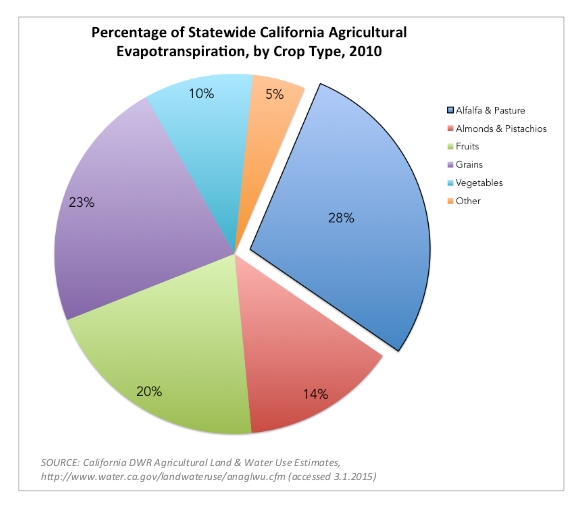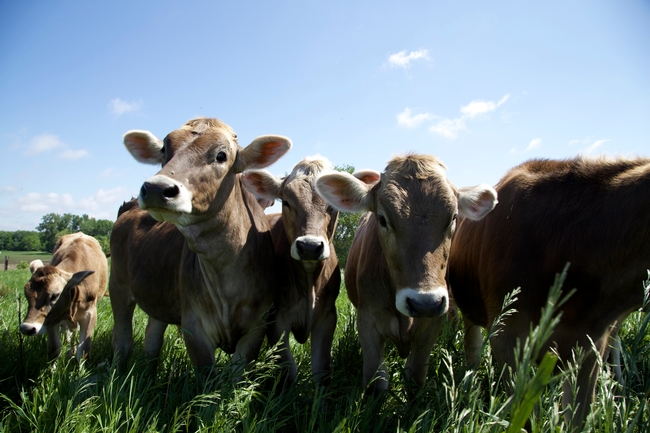We've all heard, time and again, that California farmers produce about half of this country's fruits and vegetables. The recent drought has focused attention and scrutiny on all aspects of water use in California, including agriculture. The result often plays out as news stories pitting growing urban water needs against farmers who defend their efficiency gains and crucial contribution to the country's food system (here's an example). Implicit in many of these discussions, however, is the idea that taking water away from California farmers necessarily imperils fruit and vegetable production, that a shift of water supply to urban consumers means things like fewer strawberries and tomatoes. Is that really the case though? Where does all of that irrigation water end up?
It turns out California irrigation water is just as likely to end up as cheese on your pizza as it is to be an onion or a watermelon.
In recent history, agricultural activities have accounted for about 80% of the total net water use. The term ‘net water use' commonly refers to the amount of water that is lost from the system – by transport or degradation - as a result of some activity. In agriculture, this includes loss by evapotranspiration (a so-called ‘consumptive' use) or contamination by soil salts.
With so much attention paid to the fruits and vegetables California farmers produce, one might expect the breakdown of agricultural water use in the state to be dominated by those sectors. However, data reported by the California Department of Water Resources (DWR) for 2010 suggest otherwise.
Pasture: Clover, mixed pasture, native pastures, induced high water table native pasture, miscellaneous grasses, turf farms, bermuda grass, rye grass and klein grass
Fruits: Apples, apricots, cherries, peaches, nectarines, pears, plums, prunes, figs, walnuts and miscellaneous deciduous; Grapefruit, lemons, oranges, dates, avocados, olives, kiwis, jojoba, eucalyptus and miscellaneous subtropical fruit; Table grapes, wine grapes and raisin grapes
Grains: Wheat, barley, oats, miscellaneous grain and hay, and mixed grain and hay; Rice and wild rice; Flax, hops, grain sorghum, sudan, castor beans, miscellaneous fields, sunflowers, hybrid sorghum / sudan, millet and sugar cane; Corn (field and sweet)
Vegetables: Tomatoes for processing & market; Melons, squash and cucumbers; Onions and garlic; Potatoes; Artichokes, asparagus, beans (green), carrots, celery, lettuce, peas, spinach, flowers nursery and tree farms, bush berries, strawberries, peppers, broccoli, cabbage, cauliflower and brussel sprouts
Other: Cotton; Sugar beets; dry beans, safflower
The data show that a large portion of the water evapotranspired by crops – i.e. water consumptively used in the process of growing the crop – goes not to fruits and vegetables but rather to alfalfa, pasture, and grains. In fact, the combined 30% of water used to grow fruits and vegetables is roughly equal to the 28% of water use going to alfalfa and pasture alone.
So if one out of every four gallons of water consumptively used by agriculture in California goes to forages like alfalfa, where do those forages go?
While some California alfalfa does get shipped across the country and even across the Pacific to China, roughly 75% of the alfalfa produced in California stays in the state to feed dairy cattle [1]. The ready supply of high quality forages has been one of the reasons California is now the leading producer of milk in the United States, responsible for ~20% of the national production in 2013 [2]. Increasingly, that raw milk is ending up as cheese, and more often than not that cheese is mozzarella. In 2012 about 43% of raw milk was used for cheese [3]. Mozzarella and ‘other Italian' cheeses accounted for 42% of the cheese produced from that milk. If we assume that all this cheese ends up on pizza and do some back-of-the-envelope calculations based on these estimates*, we se that a little less than 1 in every 100 gallons (0.8 %) used by crops in California ends up going to the cheese on top of your pizza. For reference, that's roughly the same amount that goes to onions, melons, or tomatoes, according to the 2010 DWR data.
This exercise in tracking agricultural water use to consumers is interesting, but doesn't necessarily lead to a meaningful conclusion on its own. Rather, it points to ideas worth contemplating in the context of water use, management and our food. First, the conversion of irrigation water to pizza cheese highlights the ‘virtual water' that gets shipped out of California in various foods and products. Second, and perhaps more importantly, the current agricultural water use configuration in California, at least in aggregate, could accommodate shifts in allocation to different farm and urban sectors without endangering fruit and nut production. Such a shift would rely on reduced alfalfa and/or dairy production, a trend that may already be underway [4,5].
*These calculations are greatly simplified and do not take into account any other uses of water along the production chain other than that needed to grow the original alfalfa feedstock.
[1] Putnam D.H., Summers C.G., Orloff S.B.. 2007. Alfalfa Production Systems in California. Publication 8287. Oakland, CA: Division of Agriculture and Natural Resources, University of California.
[2] “USDA Economic Research Service - Dairy Data.” 2015. Accessed March 2. http://www.ers.usda.gov/data-products/dairy-data.aspx.
[3] 2012 Dairy Products Utilization & Production Trends. 2013. American Dairy Products Institute.
[4] “California Dairies Look to Midwest's Greener Pastures | Harvest Public Media.” 2015. Accessed March 2. http://harvestpublicmedia.org/article/california-dairies-look- midwest%E2%80%99s-greener-pastures.
[5] Harrington, Lisa M. B., Max Lu, and David E. Kromm. 2010. “Milking the Plains: Movement of Large Dairy Operations into Southwestern Kansas.” The Geographical Review 100 (4): 538.

